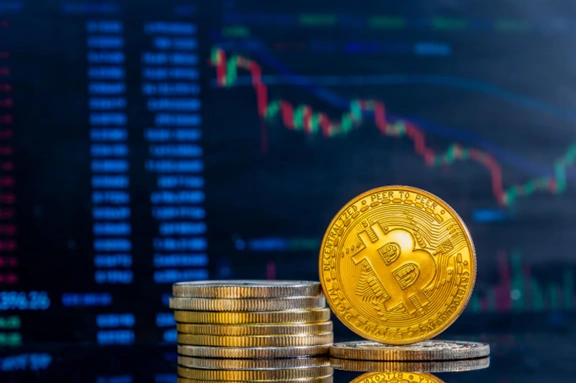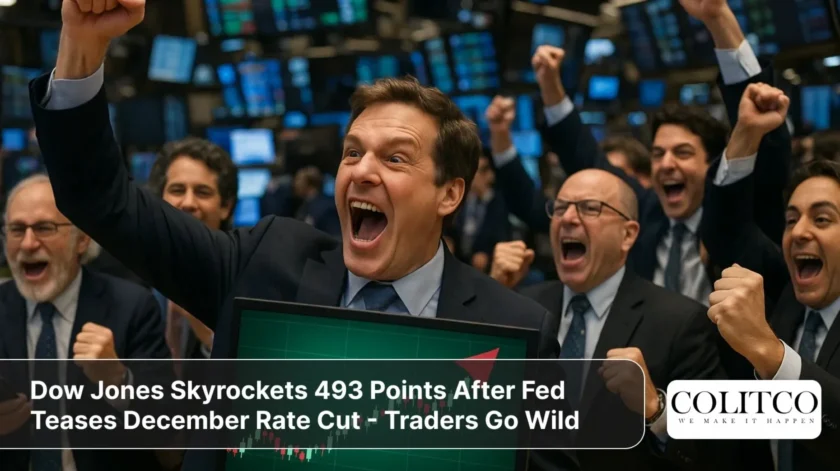The Dow Jones jumps 493 points on Friday, capping a turbulent week for Wall Street. Markets rallied after New York Federal Reserve President John Williams signalled support for near-term interest rate cuts. The unexpected shift gave traders renewed hope for a December rate reduction.

Figure 1:New York Stock Exchange
The dramatic recovery followed Thursday’s confusing market reversal. Earlier in the week, investors faced mounting uncertainty about artificial intelligence valuations and Federal Reserve policy direction. Friday’s strong finish provided much-needed relief after days of volatile trading sessions.
How the Dow Jones 493 Points Rally Unfolded
The Dow Jones 493 points gain represented a 1.08 per cent increase for the session. Markets opened stronger, with the index climbing as much as 800 points during intraday trading. The broader S&P 500 finished 0.98 per cent higher while the Nasdaq composite added 0.88 per cent.
Williams’ comments at a Chile conference sparked the immediate market response. The Fed official stated he sees “room for a further adjustment” to interest rates. His remarks contrasted with those of other Federal Reserve voices, which argued against taking action in December due to persistent concerns about inflation.
The rally marked a fitting conclusion to a week of extreme volatility. The S&P 500 finished just 4.2 per cent below its record high. However, investors endured the sharpest hour-to-hour swings since April’s tariff-induced market turmoil.
Fed Rate Cut Signals Drive Market Optimism
Financial markets found assurance in Williams’s speech about monetary policy direction. His suggestion of further rate adjustments indicated potential support for December cuts. What the Federal Reserve does remains critical for Wall Street’s trajectory moving forward.
Stock prices surged to records through recent months, partly on rate cut expectations. The Fed’s monetary policy stance directly impacts borrowing costs and investment valuations. Lower rates typically boost economic activity and support higher asset prices across financial markets.

Figure 2: New York Federal Reserve President John Williams
Traders now assign 72 per cent probability to a December rate cut. This represents a sharp increase from just 39 per cent one day earlier. Treasury yields eased on the Fed rate cut signals, with the 10-year yield falling to 4.06 per cent.
Thursday’s Dramatic Reversal Sets Stage for Dow Jones Jumps
Thursday delivered one of Wall Street’s most confusing sessions in recent memory. The Dow initially surged more than 700 points following positive economic data. However, sentiment reversed sharply by midday, erasing all gains and pushing indexes substantially lower.
The dramatic swing totalled 1,100 points for the Dow, marking its biggest reversal since April. The S&P 500 fell 1.6 per cent while the Nasdaq tumbled over 2 per cent. Nvidia shares, initially up 5 per cent, closed down 3 per cent despite strong earnings.
Traders struggled to interpret mixed signals from employment data and corporate results. Initial optimism about jobs numbers and Nvidia earnings quickly faded. Markets closed Thursday back in negative territory, resuming their slide from recent record highs.
Nvidia Earnings Impact on Dow Jones 493 Points Movement
Nvidia’s quarterly earnings initially appeared to ease artificial intelligence bubble concerns. The Company reported blow-out results Wednesday evening, showcasing continued strong demand. However, investors began questioning whether such growth pace could continue indefinitely.

The world’s most valuable Company makes high-end AI chips, powering technological advancement. Traders feared that exceptional performance might actually signal peak demand approaching. Eventually, enthusiasm for AI infrastructure investment must translate into tangible productivity gains and profits.
On Friday, Nvidia shares swung dramatically throughout the session. The stock moved from initial gains to a 4.3 per cent drop. It fluctuated repeatedly before finishing with a 1 per cent loss, reflecting ongoing uncertainty.
Individual Stock Movements Drive Index Gains
Nearly 90 per cent of S&P 500 stocks climbed despite headline volatility. Individual company movements often get overshadowed by big technology stocks. The immense size of companies like Nvidia means their price changes disproportionately affect major indexes.
Several retailers led Friday’s advance with strong earnings results. Gap surged 8.2 per cent after reporting better-than-expected quarterly profits. CEO Richard Dickson highlighted strong sales trends across Old Navy, Gap, and Banana Republic brands.
Ross Stores rallied 8.4 per cent following its positive earnings surprise. CEO Jim Conroy noted broad-based growth during the quarter. The Company raised its forecast for an important sales measure during the holiday season.
Cryptocurrency Markets Face Separate Challenges
Bitcoin experienced dramatic swings separate from equity market movements. The cryptocurrency initially rallied above USD 92,000 on Thursday before falling. It dropped to approximately USD 86,000 by late Thursday evening.

Figure 4: Bitcoin symbol representing digital currency trading
Friday brought continued pressure, with bitcoin briefly plunging below USD 81,000. The digital asset pulled back toward USD 85,000 by session end. This represents a significant decline from nearly USD 125,000 last month.
Bitcoin has returned to April price levels, coinciding with tariff-related market turbulence. The cryptocurrency is on pace for its worst monthly performance since 2022. Digital assets face challenges distinct from traditional equity markets currently.
Market Strategists Assess Current Conditions
Michael Block of Third Seven Capital noted that traders face difficult interpretations. Investors struggle to understand what constitutes success beyond Nvidia’s exceptional results. They also question how the Fed can cut rates if employment remains strong.
Brian Jacobsen of Annex Wealth Management highlighted market concentration effects. When largest companies drive most losses, the market can appear weaker than reality. Underlying breadth often tells a different story than headline index movements.
The sharp disagreement among Federal Reserve officials creates substantial uncertainty. Various Fed voices express conflicting views on appropriate December policy actions. This lack of consensus triggers dramatic back-and-forth movements for financial markets.
FAQs
Q1: What caused the Dow Jones jumps on Friday?
New York Fed President John Williams signalled support for near-term rate cuts. His comments gave traders hope for a December Federal Reserve rate reduction.
Q2: How much did the Dow Jones 493 points gain represent?
The 493-point increase represented a 1.08 per cent gain for the session. The index climbed as much as 800 points during intraday trading.
Q3: What are the Fed rate cut signals suggesting?
Markets now assign a 72 per cent probability to a December rate cut. This increased sharply from 39 per cent just one day earlier.
Q4: Why did markets reverse so dramatically on Thursday?
Investors struggled to interpret mixed signals from employment data and Nvidia earnings. Initial optimism quickly faded as traders questioned longer-term implications.
Q5: Which sectors led Friday’s market gains?
Retailers and homebuilders posted strong advances. Gap and Ross Stores surged on earnings, while housing stocks rallied on rate cut hopes.












